“The Circle”
Written by Peter Allan Fields
Directed by Corey Allen
Season 2, Episode 2
Production episode 40512-422
Original air date: October 3, 1993
Stardate: unknown
Station log: We open with some scenes from “The Homecoming,” followed by Sisko meeting with a confused Jaro. The minister thought Sisko would be doing cartwheels, as he was under the impression that Kira’s been a pain in his ass, prompting Sisko to snap, “Who gave you that impression?” He makes it clear that he doesn’t appreciate having one of his officers dismissed without consulting him, at which point Jaro makes it clear that this is a promotion for Kira as a reward for bringing Li Nalas home. Speaking of Li, part of the reason for assigning him to replace Kira is because it’s safer on the station. The Circle’s activities have escalated to assault on one of Jaro’s fellow ministers. Besides, who could be a better liaison officer than the hero of the resistance?
Jake then calls Sisko, having found the Circle’s logo graffiti’d on the door to their quarters. They’re upping their game.
Odo visits Kira in her quarters, and is shocked to find her packing. He expected better of her to just surrender to Jaro’s order, and he’s pissed that she hasn’t even asked Sisko for help. She also assures him that Li is up to the job.
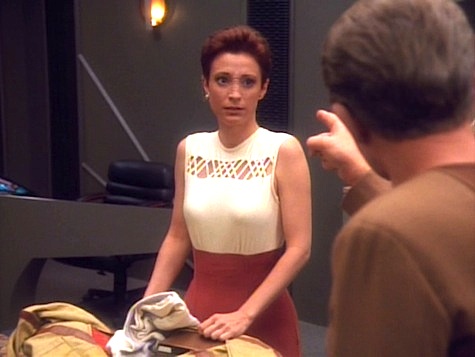
In rapid succession, Dax, Bashir, O’Brien, and Quark all enter. Dax wants to return lotion, Bashir and O’Brien want to wish Kira well, Quark thinks it’s a party (he even brought Kira’s favorite synthale), and Odo’s spending the entire time being pissed at Kira’s enforced departure.
When the doorchime rings again, this time it’s Vedek Bareil, who asks if he’s interrupting. Kira says no, then hesitates and simultaneously says and realizes that these are her friends. She’s surprised that Bareil’s here, but he says it’s best not to announce one’s movements these days—the violence on Bajor has escalated. The provisional government has told Kira to take a few days off before they decide on her new assignment, and Bareil offers his monastery as a place for her to collect herself and explore her pagh.
Kira takes one last trip to ops, where she meets up with Li and Sisko. Li says he didn’t want this job, and Kira smiles and says, “Neither did I.” Sisko promises that he’s going to get her back.

Later, Kira is at the monastery trying and failing to make a path of rocks across a stream. She has no artistic talents, and the best she can do is destroy the arboretum one stream at a time. She hates being useless, though Bareil thinks being useless might be an interesting thing for her to try.
Then, to Kira’s shock, he takes her inside to have an orb experience, something she’s wanted her whole life. Bareil leaves her with the Orb of Prophecy and Change, which gives her a vision that includes Kira in the chamber of ministers, alongside Dax dressed as a vedek; then she’s surrounded by Jaro and Vedek Winn, who tower over her; then Bareil arrives in a Bajoran Milita uniform; then Kira’s naked; then Bareil’s naked. Throughout there are voices that she can’t make out; Jaro says they’re speaking to him, but Dax and Bareil both insist they’re for Kira.
Kira doesn’t really want to talk about her vision, at which point Bareil confesses that he saw Kira in the last vision the orb gave him. That was why he invited her down. Kira then lies and says Bareil wasn’t part of her vision at all.
Just as Bareil and Kira hear gunfire in the distance, Winn shows up and snarks them off a bit, making her contempt for both of them abundantly clear.
A friend of Odo’s in planetary security tells him that the provisional government is bringing troops into the capital city, since every other attempt to stop the Circle has been stymied. The Circle has friends in high places, warning them about attempts to capture them. Quark then arrives convinced that it’s all over. The Circle, he insists, isn’t just a bunch of thugs, they’re a bunch of very, very, very well-armed thugs. Quark has learned that the Kressari are providing the Circle with a crap-ton of weapons.
Odo needs more information, so he deputizes Quark and tells him to find out where the weapons are being delivered. Quark refuses until Odo threatens to arrest him for an impeding an investigation, since he obviously won’t reveal his sources.
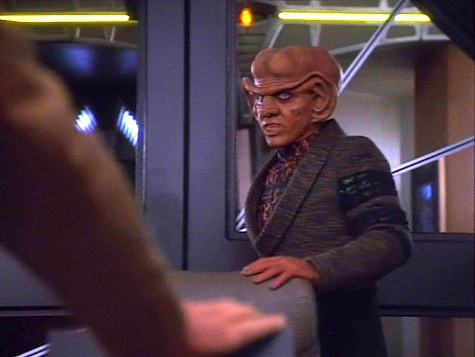
In light of this new information, Sisko is traveling to Bajor, leaving Li in charge, and asking him to see if he can find out how much support the provisional government really has. Li is sure that he’ll have help with any difficulties—“I can’t even sneeze without three people handing me handkerchiefs”—and he also suggests a curfew.
Sisko meets with General Krim, who’s in charge of the forces defending the capital city. Sisko has noticed that the military has avoided direct confrontation with the Circle, and also tells Krim about the Kressari. After promising Krim to provide him with any further information about the weapons shipments, Sisko asks Krim about Kira, hoping to get her reassigned back to DS9. Krim, however, can’t help him, as that’s out of his purview. Krim also notes that Sisko could have traded the information about the Kressari for the favor regarding Kira, and Sisko just smiles and says he wouldn’t do that. “I’ll remember that about you,” Krim says with respect.
Sisko’s next stop is the monastery to visit Kira, letting her know that he thinks the Circle is arming for a coup and that the military isn’t necessarily going to support the provisional government. He reiterates his promise to get her back.
After Sisko leaves, Kira is kidnapped by masked members of the Circle. They bring her to an underground cavern, where she is met by Jaro—who is, in fact, the head of the Circle. He wants the Federation gone, carrying the same view Kira did in “Emissary,” to wit, that they’re no better than the Cardassians. He also wants information from Kira as to how the Federation in general and Sisko in particular will react when the Circle’s endgame becomes clear. Kira, of course, refuses to talk, leaving Jaro to resort to torture.
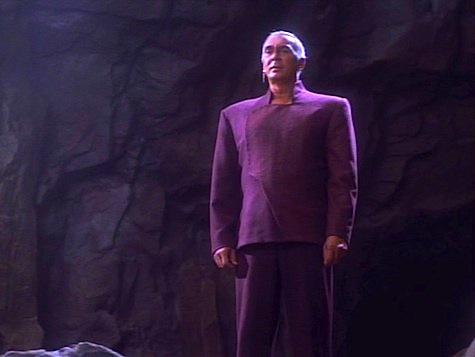
When the Kressari ship arrives, Li, Dax, and O’Brien blind them with bureaucratic nonsense as a pretense to inspect the cargo containers. Eventually, the Kressari disembark from the station, albeit with Odo as a rat-shaped stowaway. After they clear the station, a Cardassian gul beams aboard the ship and approves a weapons shipment.
Upon Sisko’s return to the station, he learns of Kira’s disappearance from Bareil. The newly (and grumpily) deputized Quark announces that he’s learned that the Circle is headquartered in caves under the Perikian Peninsula. Sisko leads a rescue party that includes O’Brien, Bashir, a security contingent, and Li—the latter at his own request. He doesn’t know what it means to be a navarch, but he can fight in the trenches, he takes orders well, and he owes Kira.
The team beams down from the runabout—O’Brien remaining behind to pilot and beam people back at the drop of a hat—with Sisko handing everyone a combadge to pin on Kira as soon as they find her. They also see that the Circle has just received a new shipment of weapons.
Those weapons get used in a firefight quickly, but Bashir finds the badly injured Kira while the two sides exchange phaser fire and they beam out.
While Bashir treats Kira in the infirmary, Odo returns with the evidence that the Cardassians are the ones secretly supplying the Circle via the Kressari. Once the Circle gets rid of the Federation, the Cardassians can waltz right in and take Bajor—and the wormhole—back.
Unfortunately, the coup has now started. All communication with Bajor has been cut off.
Jaro meets with Winn, and they broker a deal, where she’ll throw public support behind him, saying the Prophets bless his coup, in exchange for his full support in making her the new kai.
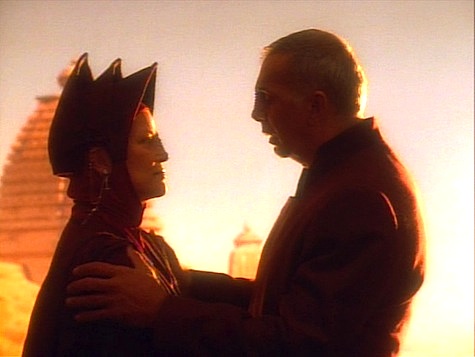
O’Brien informs Sisko that two assault vessels are on course for the station from Bajor, and they’ve given all non-Bajorans seven hours to evacuate DS9. Sisko talks to Admiral Chekote, who makes it clear that this is an internal matter to Bajor. The Cardassians may get involved in other people’s civil wars, but the Federation doesn’t, and Chekote orders Sisko to withdraw from the station.
Sisko asks O’Brien how long it would take to evacuate the station—not just the people, but all Federation property of any kind. O’Brien says it would take days, and the assault vessels will be there in seven hours.
“Then I guess some of us won’t quite be done by the time they get here.”
To be continued…
The Sisko is of Bajor: Sisko gets to verbally fence with both Jaro (whom he obviously doesn’t respect or trust, especially given the story he tells about the politician full of hot air) and Krim (whom he does respect, and that favor is returned to a degree, which will come into play in the next episode). And he comes away from both those meetings learning more from what the two men didn’t say than what they did.
Don’t ask my opinion next time: Full episode for Kira: she realizes how important the people on the station have become to her, she tries and fails at peaceful meditation, she has an orb experience, she finds out the truth about the Circle, and she gets tortured.
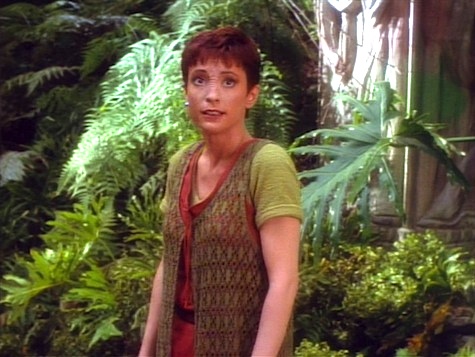
Rules of Acquisition: Quark is able to find things out from people who, as he says to Odo, “don’t talk to people like you,” thus learning how well-armed the Circle is. He’s actually the linchpin of the plot, as our heroes only realize the Circle is a force to be reckoned with (and eventually that they’re being supplied by Cardassia) from Quark’s info.
For Cardassia!: Cardassia’s reasons for not wanting to rock the boat in terms of their relationship with Bajor in “The Homecoming” come into focus here: why start a conflict over Cardassia IV’s labor camp when they plan to take Bajor back as soon as the Circle kicks the Federation out?
Preservation of mass and energy is for wimps: Odo turns into a panel surface on a container in order to stow away on the Kressari ship, then remains on board as a rat.
No sex, please, we’re Starfleet: Sparks fly like whoa between Kira and Bareil, and that’s before the Prophets provide Kira with a wet dream about the two of them.

Similar sparks fly between Jaro and Winn—it’s pretty damned obvious that, if they’re not sleeping together now, they absolutely have in the past. (Jaro’s small smile followed by an almost-playful, “Don’t tease me,” pretty much confirms it.)
Keep your ears open: “Is this a joke? Did you plan this?”
“Nobody could have planned this.”
Kira and Bashir commenting on the chaos in her quarters as half the station comes by to wish her well.
Welcome aboard: Back from “The Homecoming” are Richard Beymer as Li and a still-uncredited Frank Langella as Jaro. Back from “In the Hands of the Prophets” are Philip Anglim as Bareil and Louise Fletcher as Winn. Bruce Gray makes his first of two appearances as Admiral Chekote (he’ll return in TNG’s “Gambit Part 1” a week later) and Stephen Macht makes his first of two appearances as General Krim (he’ll be back in the next episode, “The Siege,” in a much larger role).
And then we have our Robert Knepper moment: I had no idea that was longtime character actor Mike Genovese (a favorite of mine since his role as Lieutenant Garfield on The Flash way back when) buried under the Kressari makeup.
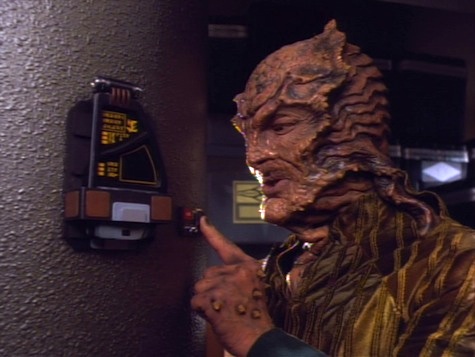
Trivial matters: This obviously continues the story begun in “The Homecoming” and will continue in “The Siege,” this being Trek’s first three-parter.
The opening of Act 1 in Kira’s quarters is a deliberate homage to the classic stateroom scene in the Marx Brothers’ A Night at the Opera. All that was missing was Quark asking for two hard-boiled eggs, then Morn honking and Quark adding, “Make that three hard-boiled eggs.”
The orb Kira experiences is identified by Bareil as the Third Orb, and also as the Orb of Prophecy and Change (the latter providing the inspiration for the title of the tenth anniversary DS9 short story anthology that your humble rewatcher contributed to). It’s unclear whether or not it’s the same orb that Sisko and Dax experienced in “Emissary,” but since they received flashback visions rather than prophetic ones, it might have been a different one. Only four of the nine original orbs will be identified by name in the show, the others being the Orbs of Wisdom (“Prophet Motive,” “In the Cards”), Time (“Trials and Tribble-ations,” “Wrongs Darker than Death or Night”), and Contemplation (“Tears of the Prophets”). The post-finale DS9 novels identified the other five as the Orbs of Memory (Avatar Books 1-2, Unity), Destiny (Cathedral, Raise the Dawn), Souls (Cathedral, Fearful Symmetry, The Soul Key), Unity (Cathedral, Unity), and Truth (Day of the Vipers).
Your humble rewatcher provided some history for the Perikian Peninsula in the novella “Horn and Ivory,” collected in both Gateways: What Lay Beyond and Twist of Faith.
Krim only appears in this storyline on screen, but he returns in the novels, being named Bajor’s representative to the Federation Council after Bajor joins the Federation in Unity. He’s assigned in the Bajor portion of Worlds of DS9 Volume 2 by J. Noah Kym and is also seen in the role in your humble rewatcher’s Articles of the Federation.
Walk with the Prophets: “I’m sure I could destroy your entire arboretum.” Unlike the previous episode, which actually had some closure in the revelation of Li’s true story and his agreeing to become navarch, this episode is entirely setup, ending with a much nastier cliffhanger, as Starfleet is basically being kicked off the station.
But it’s really good setup, as we get the sense of things escalating on Bajor, and it’s told effectively and subtly: Bareil’s need to travel in secret, the sound of gunfire frighteningly close to the monastery, and the revelation that Jaro’s behind it all, which is less surprising given that, well, the guy’s played by Frank Langella, for cryin’ out loud.
Langella also sells Jaro as an understandable (if not sympathetic) character. As Krim says at one point, “We’re all patriots, Commander,” and Jaro truly believes he’s doing what’s best for Bajor. What he doesn’t sell, because the script won’t let him, is why so clever a character can’t see the long-term implications of kicking the Federation out. Even if the Cardassians weren’t the ones arming the Circle, their goals still play right into the Cardassians’ hands, as tossing Starfleet paves the way for Cardassia to come back and claim the wormhole (which is probably a much bigger prize to them than a planet they already abandoned).
Stretching the storyline to three parts not only helps add to the scope of the story (the episode obviously takes place over the course of several days, too), it also gives time to focus on the most compelling character in all this: Kira. Her reassignment and replacement by Li serves two purposes for Jaro: punishing Kira for disobeying orders (the public reason) and getting Li out of the way so he won’t distract the public from his coup. The extra length of the story allows the entire first act and half the second be entirely about her, and Nana Visitor is, as always, completely up to the challenge. I particularly love her moment of realization when she introduces Odo, Dax, O’Brien, Bashir, and even Quark to Bareil as her friends.
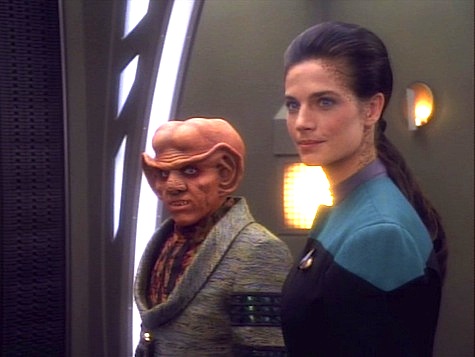
Most of the guests comport themselves well. Richard Beymer gets less to do, but his helplessness in the nigh-meaningless role of navarch is entertaining to watch. Louise Fletcher returns as Winn, and her “bless your heart” conversation with Kira and Bareil is a symphony in sweet sarcasm, followed by a delightful Evil Meeting Of Evil between her and Jaro. Stephen Macht shows tremendous gravitas as Krim, setting up his larger role in the following episode. The only weak link is Philip Anglim, whose serene presence in “In the Hands of the Prophets” is subsumed to a somewhat creepy fascination with Kira, his intense stare just barely holding back from being a leer. (Having said that, the conversations between him and Kira are beautifully done.)
I particularly like that Kira’s character evolution is really what undoes Jaro here. His entire plan is predicated on the outdated information that Sisko would dance a jig at the notion of being rid of Kira and also thinking that Kira’s contempt for the provisional government would make her an ally of his.
Warp factor rating: 8
Rewatcher’s note: I’ve launched a Kickstarter campaign for a graphic novel based on the universe of my novel Dragon Precinct and its sequels. Art will be by JK Woodward, (the artist on the Star Trek/Doctor Whocrossover comic book). Please check it out and spread the word!
Keith R.A. DeCandido is a writer and stuff.










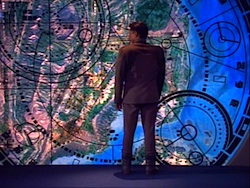
That first scene is a winner. And Sisko trying to get Kira back is everything ‘Shadows of P’jem’ was not.
I’ve been smiling and nodding along with these rewatches, for the most part, but this is the first episode where I’ve had something to contribute since Emissary.
Point the first: this is one of my go-to episodes (along with the other two parts of this story), so I do really really like this episode. I especially love the opening scene in Kira’s quarters. I didn’t know it was an homage to the Marx Bros but I absolutely adore the way the conversations overlap and the way Kira admits everyone present (even Quark) are her friends. Just a great scene.
Point the second: the conversation between Winn and Jaro is another thing of beauty, but surely I can’t be the only person who watches that scene and wonders how on earth Winn didn’t set fire to everything when she’s waving that candle lighter around?…!
Point the third: is it my imagination or does Bashir’s line “where’s is it coming from” not make a great deal of sense? I’m assuming there’s some lines cut from the rescue sequence.
Point the fourth: I’m so glad to see that I’m not the only person who finds Bareil just a little bit creepy in this episode!
Point the fifth: am I right in thinking that Odo-the-rat is actually a female rat?
I’ve always thought Bareil is kinda creepy. Not Winn-creepy, more… non-emotive stalker creepy. I never did like his relationship with Kira, it always seemed forced, like the writers wanted a Relationship to work with and Kira drew the short straw.
The scene in Kira’s quarters is one of my favorite scenes from any iteration of Star Trek. Great comedic timing, nice use of tension, and it just make me smile. Good stuff.
My only real complaint here is that I really would have liked an episode or two in season one that introduced some of these people a bit more. I feel like the contours of the coup, the motivations of the parties, etc. are all just a bit shallow. I don’t feel like I really know these characters so I just have to go with what we’re told. Not a big deal, of course, since most of the acting is good enough to sell them even based on quick portraits.
@3 agreed that Bareil is creepy. The whole Orb scene just squicked me out, especially the conversation afterwards where he seems to be trying to get her to admit to what she saw. It may partially be because of my own conceptions of religious structure, but to me it just seemed like a breach of authority. Although I’m not sure at this point if Bajoran religious are supposed to be celibate (I’m assuming no?).
I mean, look at that screenshot! HE IS CREEPY! Creepier than Geordi!
Also, I definitely got that vibe from Winn and Jaro (way, way more chemistry than Bareil and Kira, that’s for sure) but the more I think about it, I’m perfectly willing to accept that they actually haven’t slept together, and for them, all that political scheming and power gathering IS pretty much as good as sex for them, heh.
As someone watching through the series for the first time, and only a couple episodes ahead of this rewatch, my impressions are still pretty fresh, so I’d like to toss my two cents in.
For the most part, I felt Bareil is pretty weak in this episode. However, there’s one part where I feel he kind of came alive, and that’s the ‘friendly’ conversation with Winn. Both of them barely changed their demeanor at all, but it was just enough that you could nearly touch the tension in the air between them. I was soundly impressed.
The disappointing thing about that scene in Kira’s quarters is that Corey Allen and the actors shot it as a single master take, but then they had to go back and shoot coverage from other angles and the final scene is cut together from multiple takes, which just isn’t as cool as an unbroken master take would’ve been. Allen got to keep a copy of the single-take version, but we don’t get to see it. (I could’ve sworn there was a scene like this in DS9 where the whole thing was a master take. Is there a similar scene later in the series?)
I liked Stephen Macht as Krim. Wasn’t he a runner-up for the role of Picard? (Arrghh… I wrote “Steven Macht” and then went back and checked. Why do we even have two spellings of “Stephen/Steven?” It’s impossible for me to remember who uses which. And how come “Steve” is never spelled “Stephe”? Rhetorical question, don’t answer that.)
@2 re: Odo-the-rat
I keep pet rats, and I’m pretty sure that the rat used for Odo is actually an unaltered male rat. The scene just after he transforms and runs behind the crate seems to show a goodly sized pair of rat cajones.
Just an aside: I happened to watch “A Night at the Opera” Wednesday. Good stuff. I never realized that about the scene in this episode. I may have to rent DS9 on Netflix next.
The trope of Jake saying he had to come down and see the Circle sign kind of annoyed me. Couldn’t he have just said, “Someone graffitied our door?”
I loved Winn’s line to Kira about staying “as many days as you like–even a week if necessary.” Perfectly conveyed.
Now that you mention O’Brien in the runabout, did all five of the team members (plus Kira) beam out at once? I don’t remember. Doesn’t this seem to contradict his statement in the previous episode that they couldn’t beam up more than two at a time?
Creepy Bareil is Creepy. He actually reminded me of the character of Orlin in Stargate: SG-1. I never understood why that actor (or director?) chose to go completely emotionless, but I just can’t understand why Sam would not be totally creeped out by him. He was also kind of presumptuous like Bareil is, now that I think about it. I guess this is all a case of Anakin Syndrome. Why do the women characters fall for these creepy guys?
@@@@@#11 I wondered about that, when I said something about this to my wife she said if you watch they beam back up a few seconds after each other in groups of 2, I know O’brien is good but not that good. On a side note Vedek Winn would be the perfect Cads for a WoT movie.
I thought the notion of the Prophets acting as matchmakers was pretty silly.
@13: I don’t think it’s the Prophets acting as matchmakers, I think it’s just the Orbs letting the characters get a figurative/dreamlike glimpse of what their future has in store. Remember, the Prophets don’t experience time the way we do, don’t think in terms of cause and effect. To them, essentially, everything’s already happened. When we gain access to their non-temporal continuum, that allows us glimpses of the future, which we interpret as “prophecy.” But that doesn’t mean the Prophets are making that future happen.
(Granted, the later seasons did depart from that notion somewhat and took the Prophets in a more proactive/godlike direction that I think was missing the original intent behind them. But that hadn’t happened yet at this point.)
@14: Yes, I was being a bit flippant; nevertheless, the wormhole aliens raise some interesting questions about the nature of time in the Star Trek universe. If the Prophets can see the future, does that mean that revealing the future to the Bajorans has no effect on the course of events? Is there a single timeline leading to the future, or many? Since the Prophets only give the Bajorans glimpses of the future, how do the Prophets determine what to reveal to the Bajorans, and why?
There seems to be a bit of predestination lurking here that is perhaps inconsistent with other depictions of the nature of time that we’ve seen. In various time travel episodes, we’ve seen that changes to the timeline in the past can affect the present, so why don’t revelations to the Bajorans change the future? The Bajorans seem to believe that the Prophets are guiding them — are they mistaken? Are the Prophets simply telling the Bajorans to spiritually prepare themselves for what’s coming?
Like most things Star Trek, it is probably best not to think too much about such things, unless one enjoys a good, splitting headache. Usually, I put aside such questions and just go along for the ride.
@15: Again, I’m skeptical of the assumption that the Prophets are micromanaging Orb experiences, consciously choosing what each observer gets to see. When characters are in the wormhole, the Prophets speak to them directly; and in later seasons, they use Orbs to speak to Sisko directly on some occasions. But for the most part, I don’t think it’s like they have a Prophet operator standing by to take every Orb call and personally handle each question. It’s more that they’ve provided these devices that allow their users to perceive things from the extratemporal, extracausal perspective of the Prophets’ realm. The Bajorans interpret that as communing with the Prophets, but I’m not convinced that’s literally the case in every instance.
The problem is that the way the writers handled the wormhole aliens changed over time. In “Emissary,” they didn’t even understand what linear time was or how humanoids experienced cause and effect. The implication was that whatever religious significance the Bajorans had read into the Prophets and the Orbs was an incidental side effect of the wormhole aliens’ activities. But later writers increasingly treated the Prophets as more traditional deities — not as profoundly alien beings with an incompatible view of reality, but as entities that consciously intervened in mortal affairs and shaped the outcomes of events in a way that the wormhole aliens of “Emissary” wouldn’t have even understood was possible or meaningful. That’s always annoyed me about the writing of this series, the way this imaginative science fiction concept of a truly alien consciousness got lost in favor of something much more conventional.
I agree that the wormhole aliens began as a very cool sci-fi idea that slowly changed into something else. In the 7th season we will learn that the wormhole aliens really, really are in the business of matchmaking!
The purpose of the orbs, from the perspective of the wormhole aliens, never made much sense to me. When Sisko first encounters the wormhole aliens it seems that they have no knowledge of corporeal beings, and yet the Bajorans have been encountering their orbs for thousands of years. Perhaps the orbs were not meant as communications devices; rather, they were probes that the wormhole aliens launched to explore reality beyond their realm. They may have been as perplexed as the Bajorans when the Bajorans encountered the orbs. However, I’m now wandering into idle speculation.
Note: this post will contain some pretty major late-series spoilers.
@17: One has to consider the non-linear nature of the Prophets. (And yes, that’s pretty much impossible to comprehend.) Even though, from Sisko’s perspective, the Orbs were thousands of years old when he first went into the wormhole, the encounter with he could well have led to their sending them. Similarly, they may have known they had to act to cause his birth BECAUSE they met him.
It is not linear.
@18: “Similarly, they may have known they had to act to cause his birth BECAUSE they met him.”
No “may have” about it. That’s exactly what happened. Still, that’s hard to reconcile with their unfamiliarity with Sisko when he first arrived. Although I suppose that’s an error built into “Emissary” — if they live outside of time, why don’t they already know the answers to their questions?
Because in order to know the answers to their questions, someone has to tell them. If he doesn’t tell them, they don’t know the answers any time ever, but if he does, they always have and always will.
Welcome to time paradoxes 101. Check your sanity at the door.
Its early episodes like these that gave DS9 a special place in my heart. A gripping story, and you’re glued to the telly every moment. The highlight of course is the evolution of Kira Nerys. The part in Kira’s quarters where Kira realizes everyone there, including Quark, are her friends forever sticks out in my mind.
This season 2 opening trilogy is, for me, where the DS9 cast became a true ensemble. All the main cast and guest players do tremendous work in selling the tension and gravity of the situation, and this episode remains a thrill to watch twenty years later.
CLB@7, I was gonna point out that Stephen Macht auditioned for the role of Jean-Luc Picard, and I always watch this one and the next part closely to see how Macht would have performed in that role. Always fun to watch for that reason.
Oh, and I have to add, I never found Bariel to be creepy. To me Bariel was like most religious people I’ve known: quietly observant, looking into people’s souls (or in Bariel’s case, their pagh). Bariel was obviously fascinated by Kira, but he never came across to me as creepy.
(Neither did Geordi LaForge. Come on, let him alone.)
@22: Concerning Bareil’s creepiness factor, I find Philip Anglim’s languid, deadpan delivery to be eerily similar to that of David Duchovny. Perhaps, in some acting cirles, that was considered edgy back in the mid ’90s.
One thing I did find a bit creepy was the way Bareil arranged an orb experience for Kira without giving her any preparation or getting her prior consent. Apparently, he did it because Kira appeared in his most recent orb experience and we can presume that Bareil’s experience had erotic overtones just like Kira’s. Given how the Vedeks tightly control access to the orb (I believe it is the only one that wasn’t stolen by the Cardassians) that is kind of creepy. Besides that, it gives the romance storyline a cheesy, match-made-in-the-wormhole quality.
I’ve been a little behind this week with my DS9-watching, so I can’t say much about “The Circle” that hasn’t already been said, either by Keith or in the comments here. I was happy that – as in “The Homecoming” – parts of this episode were shot on location rather than on a soundstage. The location used for Bareil’s arboretum is quite lovely – according to Memory Alpha, it was shot in Ferndale, California, and we get to see a lot more of it here than in its first appearance in “In the Hands of the Prophets”.
Is it just me, or does the name Admiral Chekote sound an awful lot like Chakotay? Any connection, or just a coincidence?
@12: I don’t know, Cadsuane isn’t that creepy. If she toned down the creepy a lot, then maaaybe. Actually, minus the creepy, I could see her as Verin, though. She does have some of that kind of sweet motherly, slightly distracted quality that she tries to project to get you to believe she’s harmless when she’s totally not.
@24,
No connection between the two. Someone on staff must have just liked the name a lot.
Can anyone explain the prime directive to me? Why can the federation help Bajor against forces externally and not internally? What’s the freaking difference?
@26: The Prime Directive is about protecting other cultures’ right to self-determination, their freedom to make their own decisions about their future rather than having any external force — including the Federation — imposing its will on them. Defending a world from outside invasion helps preserve that freedom of choice. But if the Federation took sides in an internal dispute, if they decided that one Bajoran faction deserved to beat another one, then the Federation would be the ones imposing their will, taking away the Bajorans’ freedom to decide their own future.
Besides, when you meddle in the internal politics of a foreign culture, it’s very easy to misunderstand the dynamics and make the wrong choice. For instance, in the ’60s in Iran, the CIA deposed a democratically elected populist leader, Mossadeq, and restored the deposed Shah to power, in the belief that this would help protect the world from the spread of Communism and promote modernization in the Mideast. But the Shah was a brutal dictator who victimized his people horribly in the name of Westernization, and this directly provoked the rise of a militant fundamentalist backlash, and the Iranian revolution that put the Ayatollahs in power was the beginning of the wave of militant fundamentalism that’s inflamed the Mideast ever since and become the dominant threat to US security today, after Communism has fizzled out. And it’s all because we chose to force our will on another country’s internal politics without understanding that country well enough to predict the consequences.
It’s a stupid observation (this set of three episodes is so good not much can be added to what was already said); but Kira’s uniform shirt is surprisingly lacy for both her and a military uniform.
@27 – Chris: Not to mention the CIA backing and training Bin Landen and the Taliban in the 80s.
@27- Christopher, the issue I have with the Prime Directive is it wasn’t consistently applied. How many times did Federation officials interfere in Klingon domestic politics, especially during the dispute over Worf’s family honor, or the Gowron v Duras leadership conflict?
Perhaps the writers were trying to make a statement that governments enforce laws selectively instead of consistently to acquire influence.
p
@29/RMS81: The Prime Directive does allow giving assistance to a post-contact civilization if it’s requested by the rightful government. It just forbids the Federation from forcing its will on another culture, or taking sides in a military conflict. In “Sins of the Father,” Picard acted as an individual in the role of Worf’s cha’dIch because Worf requested it. In “Reunion,” K’mpec requested that Picard serve as the Arbiter of Succession, a role that required neutrality. In neither case did Starfleet unilaterally impose its interference over the Klingons’ objections or choose to support one side in the succession dispute. In both cases, Picard was just granting assistance that was explicitly requested by Klingon citizens. Therefore, it was not a Prime Directive violation. Of course, Picard did have to tread very carefully to avoid a conflict of interest, so it did push the limits, but it was allowed.
another interesting dynamic examined in this trifecta is the phenomenon of ethnic and/or religious-based insurgencies. I thought these episodes did a very good job of depicting them.
Counter-terrorism analysts and criminal profilers I’ve met say these insurgencies often are successful to a degree as long as they direct their violence towards the “right” targets. Frequently, they fail because they start directing violence towards other members of their own social group for being too conciliatory towards their opponents. In fact, I’ve read the main reason why the Irish Republican Army lost favor in Northern Ireland was because they began to commit violence against too many people in their own Irish nationalist community.
notice the Circle committed most violence against Bajorans, not aliens.
@krad: There’s a minor mistake in the “Keep your ears open” section. The exchange is between Kira and Quark, not Bashir.
I liked that scene in Kira’s quarters, great comedic value. Would’ve loved to see this in one shot.
waka: You are incorrect. “Nobody could have planned this” was spoken by Bashir, not Quark.
—Keith R.A. DeCandido
I looked it up on Memory Alpha and I indeed misheard it. Should’ve kept my ears open.
I enjoyed this one, except for one thing. Bareil’s performance is the most lifeless I have ever seen.
I’d forgotten about the little farce in Kira’s quarters, a pure delight to watch unfold again with equal bits surprise and recollection. (Must be a word for that odd sort of frisson in another language…)